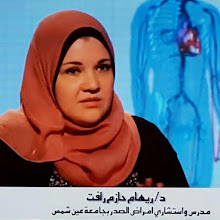A. Benign Pleural Fibroma:
-Pathology:
· Age: 40 years (but children are reported too)
· Size: small discovered accidentally à large & producing symptoms
· Shape: spherical, lobulated, well encapsulated, surrounded by compressed lung tissue
· Site: from any site in the pleural surface (visceral or parietal), connected to the pleura with a pedicle or broad base
· L/M: interlaced fibrous tissue + myxomatous degeneration + mesothelial cells or sub-mesothelial mesenchymal cells (pleomorphism with few mitotic cells)
-Clinical Picture:
.Symptoms:
· Asymptomatic
· General: fever, chills, hypoglycemia, clubbing up to osteoarthropathy (all are reversible after surgery).
· Local: symptoms of pressure à progressive dyspnea or pleuritic chest pain
.Signs:
· May mimic pleural effusion à displace mediastinum
· May mimic pericarditis (constrictive type) due to gross mediastinal displacement
-Behavior:
· Simple for a long time
· Invasive (especially after surgical resection) à Anaplastic Fibrosarcoma
· Recurrence (suspected with return of constitutional symptoms)
-Investigations:
1. CXR: appears as a dense homogenous, spherical and lobulated opacity anywhere in the pleura (if in fissure appears ovoid) ± seen with a connection to the pleura by a pedicle or broad base.
2. Biopsy: see pathology.
-Treatment:
Surgical resection as it's a potentially malignant disease (no lung tissue removed).
B. Malignant Mesothelioma:
-Definition:
It's a cancerous proliferation of mesothelial cells that usually involves a large extent of the pleural cavity.
-Etiology:
· Asbestos exposure (major risk factor of 80%) à occurs with crocidolite more with latent period of 30-45 yrs.
· Erionite fiber mineral exposure (more in
· Chest wall irradiation (very rare non-industrial cause).
-Pathology:
Mixed | Sarcomatous | Epithelial (Tubulopapillary) | Undifferentiated polygonal type |
1 : | 1 : | 2 | ---- |
Easiest to diagnose as it's a metastasis from a tumor with histological elements (LN, Bone …etc) | Cellular fibro-sarcoma with myxoma & acellular collagen | Similar to 2ry adenocarcinoma with regularly ordered cells ± dust or carbon, nuclei are vesicular with no mitosis, dilated acini appears as branching fronels lined with cuboidal cells | Sheets of polygonal or solid epithelial cells |
Asbestos bodies seen in the underlying lung tissue supports the diagnosis | |||
-Staging:
Stage I: Ipsilateral only à lung, parietal pleura, pericardium, diaphragm.
Stage II: Local invasion à chest wall, heart, LNs & esophagus.
Stage III: Penetrates diaphragm à peritoneum, opposite pleura, LNs out.
Stage IV: Distant metastasis.
-Clinical Picture:
.General: cachexia, fever, rarely clubbing & rarely LN++
.Local: Signs of pleural effusion + frozen mediastinum (more) or shift to the contralateral side (rare with massive effusion) à shift of the mediastinum to the same side (with marked pleural encasement).
-D.D.:
1. Metastatic adenocarcinoma: differentiated by immuno-histochemistry, CEA, B1 specific glycoprotein.
2. Benign asbestos pleural effusion: occurs in the 1st 20 yrs of exposure, small, asymptomatic and needs only follow-up.
3. Benign fibrous mesothelioma (pleural fibroma): see before.
4. Pleural thickening or fibrosis: see later.
-Investigations:
1. Radiology:
a) CXR:
· Large pleural effusion: earliest picture (absent in 20% of cases, can be bilateral in < 5%).
· Pleural thickening: irregular pleura.
· Pleural nodules: unilateral.
· Asbestos related plaques, calcifications, & parenchymal fibrosis.
· Spread later: pericardial effusion, mediastinal widening, and rib destruction.
b) CT chest:
· Pleural nodular thickening and encasement later.
· Pleural effusions.
· Pleuro-pulmonary changes in the opposite hemithorax.
· Evidence of local spread.
2. Functions:
a) Spirometry: progressive restrictive pattern
b) ABG: normal up to respiratory failure
3. Thoracocentesis:
a) Chemical:
· Exaudative
· Low PH
· Low glucose
· High hyaluronic acid concentration (viscid fluid).
b) Physical: straw colored, sero-sanguinous or hgic fluid.
c) Cytological: +ve for malignancy in 10% of cases.
4. Biopsy:
a) Closed: by Abram's needle (non-diagnostic small insufficient)
b) Open: diagnostic
c) VATS: useful early
-Treatment:
-Curative treatment: None
-Palliative treatment:
· Surgery (with high mortality rate so it's not done): extrapleural pneumonectomy, pleurectomy & decortication, limited pleurectomy, or thoracoscopy with talc powdrage.
· Radiotherapy: with some regression and lowering fluid accumulation.
· Chemotherapy (single agent): Adriamycin or Cyclophosphamide.
· Analgesics, palliative thoracocentesis & pleuredesis, O2 & prednisolone (decreases fever and sweating).
*Pleural Thickening or Fibrosis:
-Definition:
It's a diffuse process involving parietal and visceral layers of pleura with infrequent involvement of the surface of the lung.
-Etiology:
.Localized type: as a sequence of exaudative pleural effusion of any cause
.Generalized type:
Unilateral | Bilateral |
-TB effusion -Old artificial pneumothorax -Hemo-thorax -Empyema | -Asbestosis -Rheumatoid disease -SLE -Drugs (methyrgide, proctalol) |
With Calcification | Non Calcified except asbestosis |
-Clinical Picture:
· History of pleural effusion, asbestos exposure.
· Asymptomatic à if unilateral with no lung disease.
· Exertional dyspnea à if extensive bilateral.
· Chest pain (v rare) à suspect tumor not fibrosis.
-Investigations:
1. CXR:
· Localized thickness in the lower zone with obliteration of CP-angle.
· Streaky irregular infiltrations.
· Diffuse thickening.
· Thickening + nodular picture à suspect cancer or mesothelioma
· Atelectasis can be found.
· Calcifications can be seen.
2. CT chest: Done when:
· Mesothelioma is suspected.
· See if there is an underlying lung disease.
· Before surgery.
3. PFT:
· Restrictive pattern
· Normal DLCo
· Low Compliance
-D.D.: from malignant infiltration of mesothelioma.
-Treatment:
.Of the cause
.Pleurectomy & decortication:
· In localized type: only if there is restriction
· In diffuse type: with pre-operative assessment of underlying lung disease, persistent disability, hazards of the procedure & lung functions.
*Download from: Mesothelioma.doc

1 comment:
hey your blog design is very nice, clean and fresh and with updated content, make people feel peace and I always enjoy browsing your site.
- Murk
Post a Comment